|
|
The Holy and Great Martyr Theodore the Tyro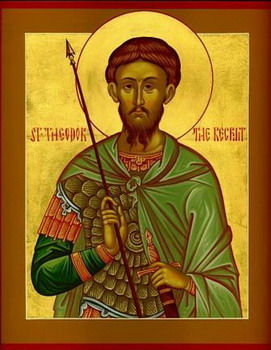 "Tyro" means "Recruit". No sooner had St Theodore entered the Marmarite regiment of the army in the town of Amasea than a persecution of Christians broke out under the Emperors Maximian and Maximinus. Theodore did not attempt to conceal that he was a Christian, and was brought to trial and imprisoned in a prison that was then locked and sealed. The wicked judge intended him to die of hunger, but the Lord Christ Himself appeared to Theodore in the prison and encouraged His martyr with these words: "Fear not, Theodore; I am with thee. Take no more earthly food and drink, for thou shalt be in the other life, eternal and unending, with Me in heaven." Then a multitude of angels appeared in the prison, and the whole place shone with light. The warders on duty saw the angels in white apparel and were filled with fear. Then St Theodore was taken out, tortured and condemned to death. He was thrown into fire, and gave his soul to the most high God. He suffered in 306. "Tyro" means "Recruit". No sooner had St Theodore entered the Marmarite regiment of the army in the town of Amasea than a persecution of Christians broke out under the Emperors Maximian and Maximinus. Theodore did not attempt to conceal that he was a Christian, and was brought to trial and imprisoned in a prison that was then locked and sealed. The wicked judge intended him to die of hunger, but the Lord Christ Himself appeared to Theodore in the prison and encouraged His martyr with these words: "Fear not, Theodore; I am with thee. Take no more earthly food and drink, for thou shalt be in the other life, eternal and unending, with Me in heaven." Then a multitude of angels appeared in the prison, and the whole place shone with light. The warders on duty saw the angels in white apparel and were filled with fear. Then St Theodore was taken out, tortured and condemned to death. He was thrown into fire, and gave his soul to the most high God. He suffered in 306.Our Holy Fathers Theodosius the Bulgarian and Romanus his pupilAs a monk, Theodosius settled not far from the town of Tmovo, where he founded a community which became known as "Theodosius"s" after him. He was prominent in the Council in Bulgaria against the Bogomils in 1360. Upholding the Orthodox faith at that Council, he put the Bogomils to shame by his reasoning. He finished his earthly course in Constantinople in 1362. His disciple, Romanus, continued in asceticism in Theodosius"s community until his death.
St Mariamna (Maria)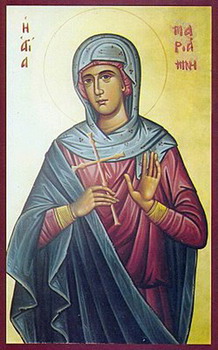 The sister of the apostle Philip, she travelled with her brother, and with him preached the, Gospel in Hierapolis and other places. After Philip had died a martyr"s death, Mariamna continued her missionary work in Lycaonia, where she died. The sister of the apostle Philip, she travelled with her brother, and with him preached the, Gospel in Hierapolis and other places. After Philip had died a martyr"s death, Mariamna continued her missionary work in Lycaonia, where she died.Saint Auxibius Bishop of Soli, Cyprus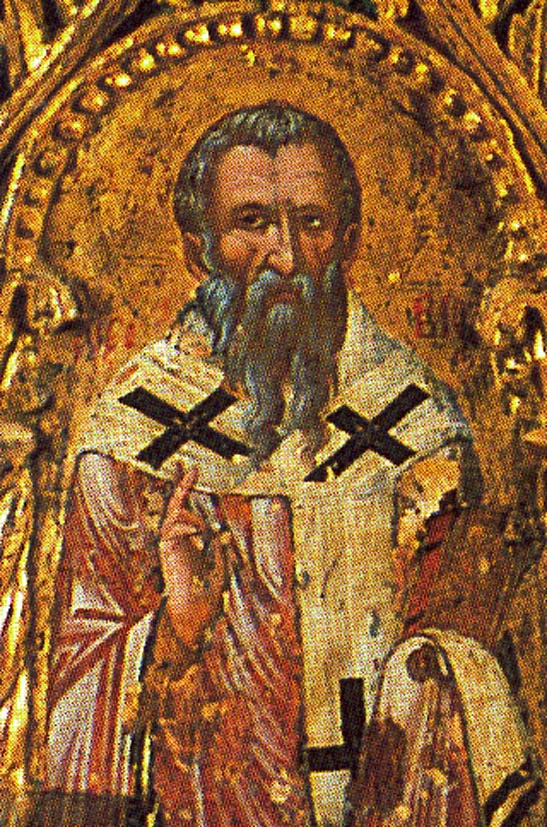 Saint Auxibius was born at Rome in a rich family. He was raised with his brother Tempstagoras, and from an early age he displayed remarkable talents. In the schools of Rome he easily learned the secular sciences. His parents wanted their son to marry. Learning of this, the youth secretly left Rome and journeyed to the East.
Arriving upon the island of Cyprus, he settled in the environs of Limnitis, not far from the city of Soli. By God’s dispensation, he encountered the holy Apostle and Evangelist Mark (September 27, October 30, January 4, April 25), preaching the Word of God at Cyprus. St Mark established Auxibius as bishop in the city of Soli, and himself went to preach at Alexandria.
St Auxibius went toward the western gates of the city and settled near the pagan temple of Zeus. Gradually he converted the local pagan priest and other idol-worshippers to Christianity. Once, St Heraklides (September 17) came to St Auxibius. He had been made a bishop in Cyprus earlier by St Mark, and he consulted with St Auxibius to preach the Gospel of ChriSt
One day, St Auxibius arrived at the marketplace and began to preach to the people about Christ. Many, seeing the miracles and the signs worked by the saint, believed in Christ. Among the converted were many people from the surrounding villages. One man, by the name of Auxinios, remained with St Auxibius and assisted him until the end of his days.
After a certain while Tempstagoras, the brother of St Auxibius, came from Rome. He was baptized with his wife, became a priest, and served in one of the churches. St Auxibius guided his diocese for fifty years and died peacefully in the year 102, leaving his disciple Auxinios upon the cathedra. Saint Auxibius was born at Rome in a rich family. He was raised with his brother Tempstagoras, and from an early age he displayed remarkable talents. In the schools of Rome he easily learned the secular sciences. His parents wanted their son to marry. Learning of this, the youth secretly left Rome and journeyed to the East.
Arriving upon the island of Cyprus, he settled in the environs of Limnitis, not far from the city of Soli. By God’s dispensation, he encountered the holy Apostle and Evangelist Mark (September 27, October 30, January 4, April 25), preaching the Word of God at Cyprus. St Mark established Auxibius as bishop in the city of Soli, and himself went to preach at Alexandria.
St Auxibius went toward the western gates of the city and settled near the pagan temple of Zeus. Gradually he converted the local pagan priest and other idol-worshippers to Christianity. Once, St Heraklides (September 17) came to St Auxibius. He had been made a bishop in Cyprus earlier by St Mark, and he consulted with St Auxibius to preach the Gospel of ChriSt
One day, St Auxibius arrived at the marketplace and began to preach to the people about Christ. Many, seeing the miracles and the signs worked by the saint, believed in Christ. Among the converted were many people from the surrounding villages. One man, by the name of Auxinios, remained with St Auxibius and assisted him until the end of his days.
After a certain while Tempstagoras, the brother of St Auxibius, came from Rome. He was baptized with his wife, became a priest, and served in one of the churches. St Auxibius guided his diocese for fifty years and died peacefully in the year 102, leaving his disciple Auxinios upon the cathedra. Saint Auxinios
Uncovering of the relics of the Martyr Menas of Alexandria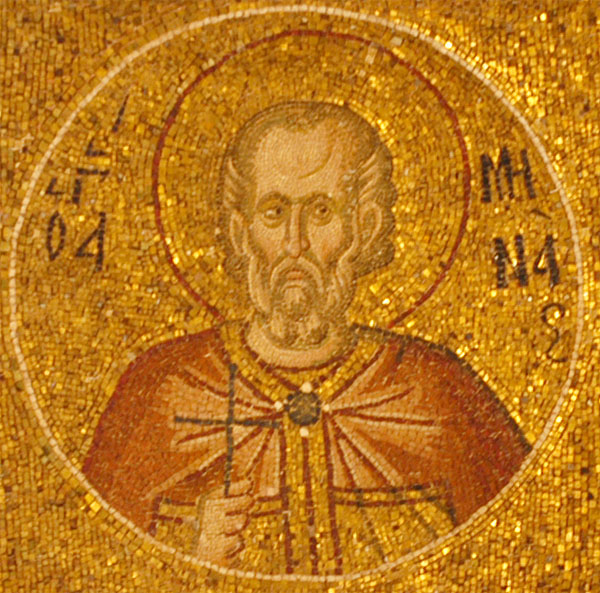 The Holy Martyr Menas Kallikelados (Well Speaking), an Athenian, died as a martyr with Sts Hermogenes and Eugraphus in about the year 313 (December 10). During the reign of Emperor Basil the Macedonian (867-886), the military commander Marcian discovered the saint’s relics after St Menas appeared to a certain pious man in a dream to reveal where they were. The Holy Martyr Menas Kallikelados (Well Speaking), an Athenian, died as a martyr with Sts Hermogenes and Eugraphus in about the year 313 (December 10). During the reign of Emperor Basil the Macedonian (867-886), the military commander Marcian discovered the saint’s relics after St Menas appeared to a certain pious man in a dream to reveal where they were. Emperor Marcian (457) and Pulcheria, his wifeNew Martyr Michael Mavroeidis of Adrianople (1490)New Martyr Theodore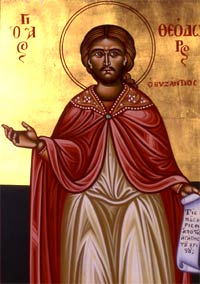 The Holy New Martyr Theodore was born of pious parents in Neochorion near Constantinople in 1774. He worked in the palace of the Sultan, where he converted to Islam.
When a plague broke out in Constantinople, he realized the gravity of his sin and returned to Christianity. He went to Chios and then to Mytilene, where he confessed Christ before the Moslem authorities. He was imprisoned, tortured, then hanged by the Turks in 1795. The Holy New Martyr Theodore was born of pious parents in Neochorion near Constantinople in 1774. He worked in the palace of the Sultan, where he converted to Islam.
When a plague broke out in Constantinople, he realized the gravity of his sin and returned to Christianity. He went to Chios and then to Mytilene, where he confessed Christ before the Moslem authorities. He was imprisoned, tortured, then hanged by the Turks in 1795. Hieromartyr Hermogenes (or Germogen)Our father among the saints Hieromartyr Hermogenes (or Germogen) (+ 1612) was the Patriarch of Moscow and of All Russia from 1606 to 1612. He is commemorated by the Church on February 17 and May 12, also with the Synaxis of the Hierarchs of Moscow on October 5.
Life
St Hermogenes was born in Kazan around 1530 and was descended from the Don Cossacks. He served as a priest in Kazan in a church dedicated to St Nicholas, near the Kazan bazaar. While he was a priest there in 1579, the wonderworking Kazan Icon of the Mother of God was discovered. With the blessing of Archbishop Jeremiah of Kazan, he carried the newly appeared icon from the place of its discovery to the Church of St Nicholas.
Soon after, he became a monk and from 1582 was made archimandrite of the Savior-Transfiguration Monastery at Kazan.
Metropolitan of Kazan
On May 13, 1589, he was consecrated bishop and became the first Metropolitan of Kazan. In 1591 the saint gathered newly baptized Tatars into the cathedral church, and for several days he instructed them in the Faith.
On January 9, 1592, St Hermogenes asked Patriarch Job for permission to commemorate in his See of Kazan those Orthodox soldiers who gave their lives for the Faith and the nation in a battle against the Tatars. He mentioned three martyrs who had suffered at Kazan for their faith in Christ, one of whom was a Russian named John (January 24), born at Nizhny Novgorod and captured by the Tatars. The other two, Stephen and Peter (March 24), were newly converted Tatars. The patriarch issued a decree on February 25 which said to celebrate throughout all the Kazan Metropolitanate a panikhida for all the Orthodox soldiers killed at Kazan and the environs of Kazan, on the Saturday following the Feast of the Protection of the Most Holy Theotokos (October 1). The patriarch also ordered that the three Kazan martyrs be inscribed in the Synodicon.
St Hermogenes displayed passion in the observance of Church traditions, and he devoted himself to enlightening the Kazan Tatars with the faith of Christ.
Patriarch
Metropolitan Hermogenes was elected to the primatial see on July 3, 1606. He was installed as patriarch by the Assembly of the Holy Hierarchs at Moscow's Dormition Cathedral. Metropolitan Isidore handed the patriarch the staff of the Holy Hierarch Peter, Moscow Wonderworker, and the tsar gave as a gift to the new patriarch a panagia embellished with precious stones, a white klobuk, and a staff. Patriarch Hermogenes made his entrance riding upon a donkey, as was the ancient way.
The new first hierarch devoted all his powers to the service of the Church and the nation. But this was a time of troubles for the Russian state with the appearance of the false Demetrius (or Dmitr(i)y, an impostor claiming to be the son of Ivan the Terrible) and the Polish king Sigismund III. The patriarch stood up against the traitors and enemies of the nation, who wanted to spread Uniatism and Western Catholicism throughout Russia and to wipe out Orthodoxy while enslaving the Russian nation.
When the impostor arrived at Moscow and settled himself at Tushino, Patriarch Hermogenes sent two letters to the Russian traitors reminding them of their faith and their country. False Dmitry was killed by his own close associates on December 11, 1610. But Moscow continued to remain in peril, since the Poles and traitors, loyal to Sigismund III, remained in the city.
Documents sent by Patriarch Hermogenes throughout the cities and villages urged the Russian nation to liberate Moscow and to choose a lawful Russian tsar. The Muscovites rose up in rebellion. The Poles burned the city, shutting themselves up in the Kremlin. Together with Russian traitors, they forcefully seized Patriarch Hermogenes and imprisoned him in the Chudov Monastery.
While still in prison, the Hieromartyr Hermogenes sent a final epistle to the Russian nation, blessing the liberating army to fight the invaders. He suffered for more than nine months in confinement, and on February 17, 1612, he died a martyr's death from starvation. The body of the hieromartyr was buried in the Chudov Monastery and in 1654 before being transferred to the Moscow Dormition Cathedral. The glorification of Patriarch Hermogenes occurred on May 12, 1913.
Saint FinanFinan of Lindisfarne (died 17 February 661), also known as Saint Finan, was an Irish monk, trained at Iona in Scotland, who became the second Bishop of Lindisfarne from 651 until 661.
Originally from Ireland, he built on Lindisfarne, a cathedral "in the Irish fashion", employing hewn oak, with a thatched roof, dedicated to St. Peter. He also founded St. Mary's at the mouth of the River Tyne. He converted the kings Sigebert of Essex and Peada of the Middle Angles to Christianity. Bede is the main source for Finan's life. He is specially noticed by the Venerable Bede as having borne an important part in the conversion of the northern Saxons.
The breviary of Aberdeen styles him "a man of venerable life, a bishop of great sanctity, an eloquent teacher ... remarkable for his training in virtue and his liberal education, surpassing all his equals in every manner of knowledge as well as in circumspection and prudence, but chiefly devoting himself to good works and presenting in his life, a most apt example of virtue". Finan ordained St. Cedd bishop of the East-Saxons, having called two other bishops to assist at his consecration.
The Abbey of Whitby, his chief foundation, was the scene of the famous Paschal controversy, which resulted in the withdrawal of the Irish monks from Lindisfarne.
Finan was active for some time at a monastery on Church Island on Lough Currane in County Kerry; today it is known as St. Finan's Church. To the south of the lake is Inis Uasal (Noble Island), an island which is dedicated to him.
Finan died and was buried at Lindisfarne, having held that see ten years.
|